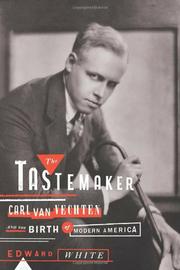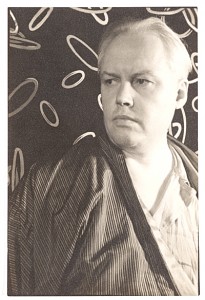 The Tastemaker: Carl van Vechten
The Tastemaker: Carl van Vechten
and the Birth of Modern America
by Edward White
Farrar, Straus & Giroux. 384 pages, $30.
THE LAST TWO DECADES have seen a strong revival of interest in Carl van Vechten (1880-1964), the Midwestern author, patron of and enthusiast for Harlem Renaissance writers, for “Jazz Age” Negro subculture and, more broadly, for 1920s Americanized dandyism and decadence. Yet, understandably, no single sense of why we should return to, or even reclaim, van Vechten, has emerged.
NYRB Classics evidently thinks The Tiger in the House: A Cultural History of the Cat (1920, reprinted 2007) is his masterpiece—though one senses here the pull of the marketplace. Bruce Kellner has more adventurously overseen the first publication of van Vechten’s journals as The Splendid Drunken Twenties: Selections from the Daybooks, 1922–30 (2007). In 2012, Yale published Emily Bernard’s somewhat pedestrian “partial biography,” Carl Van Vechten and the Harlem Renaissance, concentrating on the subject’s

“black life.” Bernard had previously edited the 2002 volume Remember Me to Harlem, the collected correspondence of van Vechten and African-American poet Langston Hughes. In July 2013, Columbia University Press brought us the first paperback edition of The Letters of Gertrude Stein and Carl Van Vechten, 1913–1946, edited by Edward Burns, weighing in at a very Steinian 920 pages and perhaps also confirming that interest in van Vechten today primarily lay in whom he knew, not in what he achieved. Now, however, van Vechten receives the copious and discriminating biographical analysis he has long needed, in the form of The Tastemaker, an exceptional publication and Edward White’s first book.
The elephant in the room throughout all this attention is captured in a single word—“the n word,” rarely seen today in publishing or in public discourse. But in 1999 Illinois republished van Vechten’s bestselling novel, Nigger Heaven, which brought forth some concern—though White shows carefully that similar concerns had been every bit as pronounced when it was first published in 1926. Van Vechten had already dipped his toe in the water of this particular controversy, in a sense, by persuading the English novelist Ronald Firbank that his Caribbean-set novel Sorrow in Sunlight would enjoy renown and huge sales stateside if the title were changed to Prancing Nigger (1924). Firbank agreed to the switch, indeed securing his only commercial success, either in the U.S. or in Britain. Van Vech-ten, meanwhile, was able to promote the book, but was also testing the water relative to using the notorious slur in a title.
Two years later, Nigger Heaven—an ironic reference, van Vechten insisted, to a nickname for the cheap seats at the top of any theater frequented by African-Americans—sought not so much to document Negro lives, cultures, and mores, as to subject them to satire. Firbank’s novel had deployed humor in portraying the journey of the Mouth Family to “the Celestial city of Cuna-Cuna,” but the esprit was evidently warm-hearted. Van Vechten’s novel meant to celebrate Harlem, but in a “warts and all” style that many African-Americans resented. Artists and writers understandably did not relish the sense that among their greatest achievements were the speakeasies where louche white cats drank all night alongside their black peers, invariably being offered a range of extra divertissements for an additional fee. Some figures of the Harlem Renaissance—Countee Cullen and W. E. B. Du Bois among them—protested the novel’s title. Other of van Vechten’s friends, such as James Weldon Johnson and Langston Hughes, stayed loyal, but even they defended the book with caution. Hughes noted the problem of “the n word” thus, even while promoting Nigger Heaven:
The word nigger, you see, sums up for us who are colored all the bitter years of insult and struggle in America: the slave-beatings of yesterday, the lynchings of today, the Jim Crow cars, the only movie show in town with its sign up for whites only, the restaurants where you may not eat, the jobs you may not have. The unions you cannot join. The word nigger in the mouths of little white boys at school, the word nigger in the mouths of foremen on the job, the word nigger across the whole face of America!
The oddest thing to emerge from White’s extensive researches is the extent to which van Vechten, as an established author in mid-career, was continually waging a private battle with his Iowan family. His father, particularly, Carl simply wanted to shock. On the one hand, Charles van Vechten had been and remained a provincial conservative, epitomizing the small-town values of Cedar Rapids, van Vechten’s birthplace. Earlier novels, with their less-than-subtle homoerotic innuendoes—such as Peter Whiffle (1922), The Blind Bow-Boy (1923), and The Tattooed Countess (1924)—had scandalized his father accordingly. The middle title here, he told his son, was “a very well-written picture of depravity.” On the other hand, the van Vechtens were relatively enlightened by the standards of the day in terms of race. For example, Charles wrote accusingly to Carl on reading Nigger Heaven: “I have myself never spoken of a colored man as a ‘nigger.’”
White’s account of van Vechten’s turbulent and multi-faceted career is undoubtedly the best we’ll get—and the best its subject could hope for. Informed, nuanced, and balanced, it hesitates to make claims for the writer that would be hard to support. Yet it vigorously argues for the efficacy of van Vechten’s best novels, such as the autobiographical Peter Whiffle and the many jazz-themed and jazz-styled stories he collected in 1930’s Parties. Ultimately, though, the title of The Tastemaker, it is true, concedes that van Vechten’s most enduring achievements did not lie in his own creativity at all, but in his advocacy of forms of art, and ways of living, through his critical reviews, private recommendations to publishers, sponsorship, and so on.
The Tastemaker has pace and brio; White is helped throughout by the sheer vivacity of his subject. The book Parties readily summarized the lifestyles in which van Vechten specialized; his writings were always singularly informed by personal experience. He and his second wife, the long-suffering actress Fani Marinoff, could drink almost everyone under the table. They were married for fifty years, though they lived independently and for long periods separately. Throughout his life, van Vechten was, it transpires, open to all offers.
The photographic career into which he moved later in life included portraiture for money as well as van Vechten’s own interests. There were few African-American artists of any kind who did not appear before his lens. But there was an avant-garde thread, too, in which young male beauty, reflected in both the fair- and dark-skinned, was unambiguously celebrated.
Van Vechten was, White demonstrates, as imaginative in his many newspaper reviews as he was in his fiction. He willingly elaborated on events, and certainly at times reviewed things he could not possibly have seen. He was as disposed to comment on a fellow audience member’s body odor as on the stagecraft in front of him. A fan of Oscar Wilde, he rhapsodized over each revival of Wilde’s plays, particularly a 1907 performance by Olive Fremstad as Salome in Richard Strauss’ operatic adaptation of Wilde’s play at the Met.
A half-century later, the world had moved on, and van Vechten’s support for African-American authors, composers, musicians, and actors seemed quaint or even corrupt. In a sense, he was eclipsed as society moved steadfastly in his direction. He donated his monumental collection of African-American cultural artifacts to Yale but named it the James Weldon Johnson Memorial Collection of Negro Arts and Letters, knowing that it would thus attract many more contributions than if his own name figured prominently.
White wittily summarizes van Vechten’s broader political naïveté as the belief “that the world could be revolutionized one cocktail party at a time.” Still, New York City in particular has always had a place for the unrepentant hedonist. True to form, in his last weeks, in 1963, van Vechten was interviewed by the New Yorker, still stylishly dressed, still downing a Bourbon highball—and still very much, as the magazine put it, “one of the city’s most durable boosters.”
Richard Canning’s most recent publication is an edition of Ronald Firbank’s Vainglory for Penguin Classics (2012).





